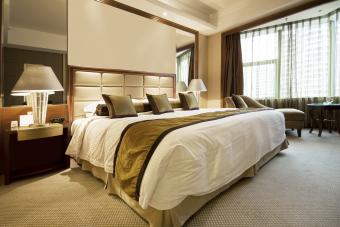
Chenille bedspreads give a feeling of nostalgia to your bedroom décor.
Chenille Material
Chenille is synonymous with bedrooms and bathrooms. You've probably seen or even owned items made out of chenille material. Perhaps your grandmother had a favorite chenille bedspread and pillows. Maybe you own a chenille robe or possibly a bath mat or bedroom rug.
The allure of chenille is two fold. The first attraction is the softness of the raised yarn material. The second appeal factor is the unique designs and colors. Chenille bedspreads have a romantic and mystical intriguing effect when you see one for the first time. Chances are you recall that moment and the feel of running your hand over the soft textured bedspread.
What Makes It Chenille
Chenille material is French for the word, caterpillar, and is best known as a fabric used for cotton bedspreads and bathrobes in the late 1920s and early 1930s. Most of the chenille manufactured is made from cotton, although it can be made from wool, olefin, acrylic, mohair, or rayon.
History of Chenille Yarn
Chenille yarn first appeared on the scene sometime during the eighteenth century. Georgia was soon the hub for chenille bedspread manufacturing. Patterns, often intricate and multi-colored, were printed onto the cotton fabric and then contracted out to individual seamstresses to be hand-sewn, using the leno weaving technique.
The Process: Chenille Bedspreads
You may wonder exactly how manufacturers created that chenille effect. The tufted yarn is created by weaving the fabric together into what's called a leno weave. Simply stated, a leno is created when short tufts of yarn were place between two warp yarns and then twisted together. These yarns are sewn to the core at right angles to the core yarn. The yarn is then trimmed to the specifications for the desired tuft height. The tufts of yarn are then sewn onto the bedspread material. This process of creating a leno, causes the yarn tufts to stand upright. The contrast of the cotton bedspread material and the raised tufts of yarns give a unique visual appeal. You'll be drawn to run your hand over the tops of the trimmed tufted yarn (piles).
Uses of Chenille
The typical uses for chenille are bedspreads. With the growing popularity of this look, the use of chenille caught on and soon throws, pillows, shams, comforters, draperies, valances, rugs, and carpets were being created. It wasn't until the late 1970s that chenille was used in other kinds of apparel such as robes, bed jackets and even slippers.
Manufacturing Advances
The original chenille often had problems associated with wear and long-time use that cause the yarn tufts to eventually unravel. Because of the tufting of the yarn, many chenille bedspreads, throws and even bathrobes required dry-cleaning. All of that changed in the early 1990s when new technology allowed for design changes. The old problems of the yarn tufts becoming loose and tearing away from the bedspread material, leaving bare spots within the tufted design, was no longer a common complaint.
Colors and Designs
One of the pleasing aspects and the beauty of chenille are the manufacturers' ability to create intricate patterns using the tufts to define various patterns. The solid fabric serves as a solid backdrop.
Some of the original designs were quite colorful. The background color was often a stark white contrasted with varying bright colors. Vintage bedspreads sometimes depicted a flower garden theme while others were a solid white or beige. The designs were often intricate and some because standards such as the Martha Washington bedspread design. The ability to use colorful tufting against a solid-colored background provided high-contrast and added dimension to the overall design.
Creating Chenille Bedrooms
You may decide to use only chenille bedspreads in your bedrooms or choose to add pillow shams, bedding ensembles, and even chenille rugs for a complete nostalgic look.







